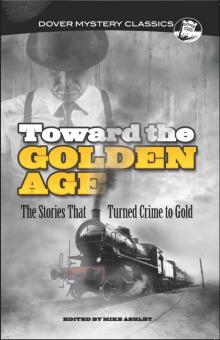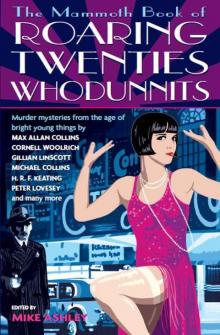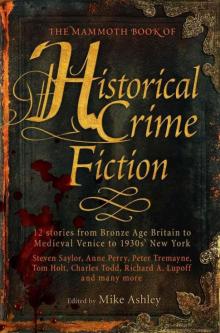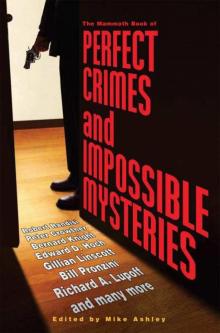- Home
- Ashley, Mike;
The Mammoth Book of Extreme Science Fiction
The Mammoth Book of Extreme Science Fiction Read online
THE MAMMOTH BOOK OF
EXTREME SCIENCE FICTION
Also available
The Mammoth Book of 20th Century Science Fiction
The Mammoth Book of Best New Erotica 4
The Mammoth Book of Best New Horror 16
The Mammoth Book of Best New Science Fiction 18
The Mammoth Book of Celebrity Murder
The Mammoth Book of Celtic Myths and Legends
The Mammoth Book of Chess
The Mammoth Book of Comic Fantasy
The Mammoth Book of Comic Quotes
The Mammoth Book of Dirty, Sick X-Rated & Politically Incorrect Jokes
The Mammoth Book of Egyptian Whodunnits
The Mammoth Book of Erotic Online Diaries
The Mammoth Book of Erotic Photography
The Mammoth Book of Erotic Women
The Mammoth Book of Great Detective Stories
The Mammoth Book of Great Inventions
The Mammoth Book of Haunted House Stories
The Mammoth Book of Historical Whodunnits
The Mammoth Book of Illustrated True Crime
The Mammoth Book of IQ Puzzles
The Mammoth Book of How It Happened: Ancient Egypt
The Mammoth Book of How It Happened: Ancient Rome
The Mammoth Book of How It Happened: Battles
The Mammoth Book of How It Happened: Trafalgar
The Mammoth Book of How It Happened: WWI
The Mammoth Book of How It Happened: WW II
The Mammoth Book of Jokes
The Mammoth Book of King Arthur
The Mammoth Book of Lesbian Erotica
The Mammoth Book of Maneaters
The Mammoth Book of Mountain Disasters
The Mammoth Book of New Terror
The Mammoth Book of New Jules Verne Adventures
The Mammoth Book of On the Road
The Mammoth Book of Private Eye Stories
The Mammoth Book of Roaring Twenties Whodunnits
The Mammoth Book of Roman Whodunnits
The Mammoth Book of Seriously Comic Fantasy
The Mammoth Book of Sex, Drugs & Rock ‘n’ Roll
The Mammoth Book of Short Spy Novels
The Mammoth Book of Sorcerers’ Tales
The Mammoth Book of Space Exploration and Disasters
The Mammoth Book of SAS & Special Forces
The Mammoth Book of Shipwrecks & Sea Disasters
The Mammoth Book of Short Erotic Novels
The Mammoth Book of On The Edge
The Mammoth Book of Travel in Dangerous Places
The Mammoth Book of True Crime
The Mammoth Book of True War Stories
The Mammoth Book of Unsolved Crimes
The Mammoth Book of Vampires
The Mammoth Book of Wild Journeys
The Mammoth Book of Women’s Fantasies
The Mammoth Book of Women Who Kill
The Mammoth Book of the World’s Greatest Chess Games
The Mammoth Encyclopedia of Unsolved Mysteries
THE MAMMOTH BOOK OF
EXTREME
SCIENCE
FICTION
Edited by Mike Ashley
Constable & Robinson Ltd
3 The Lanchesters
162 Fulham Palace Road
London W6 9ER
www.constablerobinson.com
First published in the UK by Robinson,
an imprint of Constable & Robinson Ltd 2006
Collection and editorial material © Mike Ashley 2006
All rights reserved. This book is sold subject to the condition that it shall not,
by way of trade or otherwise, be lent, re-sold, hired out or otherwise circulated
in any form of binding or cover other than that in which it is published and
without a similar condition including this condition being imposed on the
subsequent purchaser.
A copy of the British Library Cataloguing in Publication Data is available
from the British Library
UK ISBN 978-1-84529-307-9
5 7 9 10 8 6
First published in the United States in 2006 by Carroll & Graf Publishers
This edition published in 2007 by Running Press Book Publishers
All rights reserved under the Pan-American and International
Copyright Conventions
This book may not be reproduced in whole or in part, in any form or by any
means, electronic or mechanical, including photocopying, recording, or by any
information storage and retrieval system now known or hereafter invented,
without written permission from the publisher.
9 8 7 6 5 4 3
Digit on the right indicates the number of this printing
Library of Congress Cataloging-in-Publication Data is available on file
US ISBN: 978-0-7867-1727-9
Running Press Book Publishers
2300 Chestnut Street
Philadelphia, PA 19103-4371
Visit us on the web!
www.runningpress.com
CONTENTS
Copyright and Acknowledgments
EXTREME SCIENCE FICTION
Mike Ashley
ANOMALIES
Gregory Benford
. . . AND THE DISH RAN AWAY WITH THE SPOON
Paul Di Filippo
CRUCIFIXION VARIATIONS
Lawrence Person
THE PACIFIC MYSTERY
Stephen Baxter
FLOWERS FROM ALICE
Cory Doctorow & Charles Stross
MERLIN’S GUN
Alastair Reynolds
DEATH IN THE PROMISED LAND
Pat Cadigan
THE LONG CHASE
Geoffrey A. Landis
WATERWORLD
Stephen L. Gillett & Jerry Oltion
HOOP-OF-BENZENE
Robert Reed
THE NEW HUMANS
B. Vallance
THE CREATOR
Clifford D. Simak
THE GIRL HAD GUTS
Theodore Sturgeon
THE REGION BETWEEN
Harlan Ellison
THE DAYS OF SOLOMON GURSKY
Ian McDonald
WANG’S CARPETS
Greg Egan
UNDONE
James Patrick Kelly
JUDGMENT ENGINE
Greg Bear
STUFFING
Jerry Oltion
COPYRIGHT AND
ACKNOWLEDGMENTS
I would like to thank those who came up with their own suggestions of extreme sf stories including Gordon Van Gelder, Rich Horton, Todd Mason, David Pringle, Andy Robertson and in particular Jetse de Vries, whose taste coincides remarkably with my own. All of the stories are copyright in the name of the individual authors or their estates as follows. Every effort has been made to trace holders of copyright. In the event of any inadvertent transgression please contact the editor via the publisher.
“The Pacific Mystery” © 2006 by Stephen Baxter. First publication, original to this anthology. Printed by permission of the author.
“Judgment Engine” © 1995 by Greg Bear. First published in Far Futures edited by Gregory Benford (New York: Tor Books, 1995). Reprinted by permission of the author.
“Anomalies” by Gregory Benford © 1999 by Abbenford Associaties. First published in Redshift edited by Al Sarrantonio (New York: Roc Books, 2001). Reprinted by permission of the author.
“Death in the Promised Land” © 1995 by Pat Cadigan. First published by OMNI Online in March 1995 and first printed in Asimov’s Science Fiction, November 1995. Reprinted by pe
rmission of the author.
“. . . And the Dish Ran Away with the Spoon” © 2003 by Paul Di Filippo. First published by SCI FICTION, 19 November 2003. Reprinted by permission of the author.
“Flowers from Alice” © 2003 by Cory Doctorow and Charles Stross. First published in New Voices in Science Fiction edited by Mike Resnick (New York: DAW Books, 2003). Reprinted by permission of the authors.
“Wang’s Carpets” © 1995 by Greg Egan. First published in New Legends edited by Greg Bear (London and New York: Legend Books, 1995). Reprinted by permission of the author.
“The Region Between” © 1969 by harlan Ellison. Renewed 1997 by The Kilimanjaro Corporation. First published in Galaxy Science Fiction Magazine, March 1970. Reprinted by arrangement with and permission of the author and the author’s agent, Richard Curtis Associates, Inc., New York. All rights reserved. Harlan Ellison is a registered trademark of The Kilimanjaro Corporation.
“Waterworld” © 1994 by Stephen Gillett & Jerry Oltion. First published in Analog Science Fiction and Fact, March 1994. Reprinted by permission of the authors.
“Undone” © 2001 by James Patrick Kelly. First published in Asimov’s Science Fiction, June 2001. Reprinted by permission of the author.
“The Long Chase” © 2002 by Geoffrey A. Landis. First published in Asimov’s Science Fiction, February 2002. Reprinted by permission of the author.
“The Days of Solomon Gursky” © 1998 by Ian McDonald. First published in Asimov’s Science Fiction, June 1998. Reprinted by permission of the author.
“Stuffing” © 2006 by Jerry Oltion. First publication, original to this anthology. Printed by permission of the author.
“Crucifixion Varations” © 1998 by Lawrence Person. First published in Asimov’s Science Fiction, May 1998. Reprinted by permission of the author.
“Hoop-of-Benzene” © 2006 by Robert Reed. First publication, original to this anthology. Printed by permission of the author.
“Merlin’s Gun” © 2000 by Alastair Reynolds. First pubolished in Asimov’s Science Fiction, May 2000. Reprinted by persmission of the author.
“The Creator” © 1935 by Clifford D. Simak. First published in Marvel Tales, March-April 1935. Reprinted by permisison of David Wixon on behalf of the author’s estate.
“The Girl Had Guts” © 1956 by Theodore Sturgeon. First published in Venture Science Fiction, January 1957. Reprinted by permission of The Theodore Sturgeon Literary Trust c/o Ralph M. Vicinanza, Ltd.
“The New Humans” © 1909 by B. Vallance. First published in Pearson’s Magazine, December 1909. Unable to trace the author or their estate.
EXTREME SCIENCE FICTION
If science fiction is the literature of ideas, then extreme science fiction is about extreme ideas. What you will find in this anthology are some wonderful ideas, which may in themselves be either simple or complicated, but which the author has taken to an extreme – be it extreme circumstances, an extreme location, extreme science or extreme concepts.
But there is a limit! These stories may push back boundaries and challenge existing beliefs and theories, but not at the sake of everything else. At their heart these are good, sound stories – there’s nothing experimental or avant garde about them – and you don’t need a science degree or an IQ over 200 to understand them. That’s not what it’s about. It’s about having fun with a thought, an idea, a vision. Science fiction is the best medium for doing this and the best science fiction is that which does push limits.
Let me give you some idea of what you’ll find here.
An Earth where the Pacific has never been crossed because somehow the Earth doesn’t quite join up.
crimes committed in virtual reality.
household machines that become sentient and take control.
a world made entirely of water.
someone lost in time trying to get back to where they started.
what happens if we all stop eating food.
That’s just a half-dozen of the ideas included in the nineteen stories in this collection. Not all are extreme in themselves, it’s what the author does with them.
Most of the stories are of a fairly recent vintage, written in the last ten or twelve years (three of them have their first appearance here). For the most part I wanted stories that were at the cutting edge of science and society. We have witnessed a colossal change in technological advance in the last twenty years or so and the pace of advance is increasing at a formidable rate. I wanted stories that recognized that pace of change and which incorporated much of the new technology and understanding.
But I didn’t want to exclude older science fiction. In fact one could argue than in its youth science fiction was at its most extreme. After all, imagine just how revolutionary Mary Shelley’s Frankenstein was when it first appeared in 1818, or H. G. Wells’s The Time Machine in 1895. That took us firstly 800,000 years and then millions of years into the future. Or Edwin Abbott’s Flatland (1884) which explored a world of only two dimensions. That amazing philosopher Olaf Stapledon produced what must be one of the most extreme works of sf ever written with The Star Maker, published in 1937. This book has an observer witness the entire history of the Universe in which the part played by humanity is but a few pages. These works were certainly extreme for their day.
Some of these older stories have dated a little today, though they are still fun to read, and many are just too long to squeeze in, so I have been highly selective in what few stories I have reprinted from beyond the last thirty years. But I think you’ll be surprised.
Over the years there have been plenty of magazines and anthologies that have sought to break down barriers and taboos, most notably Harlan Ellison’s Dangerous Visions, and there are a couple of examples of such stories included here. But this anthology isn’t designed as one that breaks taboos – such that remain. It’s designed to show what science fiction can do when it lets its hair down, which means that you are in for a roller coaster ride of awe and wonder.
I’ve arranged the book so that it starts with the least extreme and builds up to the most extreme, although the very last story allows us a mental cool down. So tread carefully. From here on the brakes are off.
Mike Ashley, December 2005
ANOMALIES
Gregory Benford
I could have filled this book entirely with stories by Greg Benford as he has written some of the best “extreme sf” of recent years. Just check out his collection Worlds Vast and Various (2000) for some of the latest examples. Benford (b. 1941) is a professor of physics at the University of California, Irvine, specializing in plasma turbulence and astrophysics. He advises NASA on national space policy and has been heavily involved in the Mars exploration programme. His novels, The Martian Race (1999) and The Sunborn (2005), are generally regarded as amongst the most authentic considerations of the race to and exploration of Mars. In 1995 he received the prestigious Lord Foundation award for scientific achievement.
In the world of science fiction, Benford has received many awards including the Nebula for Timescape (1980), still one of the most realistic time-travel novels. His most sustained sequence of books is the Galactic Centre series, tracing the continuing conflict between organic life forms and AI machines. The series began with Across the Sea of Suns (1983). Amongst his more recent novels perhaps the most extreme is Cosm (1998) involving an artificially created micro-universe. You might also want to check out the anthology he edited, Far Futures (1995), which is full of extreme sf, including Greg Bear’s story, which you’ll find later in this volume.
To get us underway, here is Benford in milder, somewhat tongue-in-cheek, mood.
It was not lost upon the Astronomer Royal that the greatest scientific discovery of all time was made by a carpenter and amateur astronomer from the neighbouring cathedral town of Ely. Not by a Cambridge man.
Geoffrey Carlisle had a plain directness that apparently came from his profession, a custom cabinet-maker. It had enabled him to get past the practised deflection skill
s of the receptionist at the Institute for Astronomy, through the Assistant Director’s patented brush-off, and into the Astronomer Royal’s corner office.
Running this gauntlet took until early afternoon, as the sun broke through a shroud of soft rain. Geoffrey wasted no time. He dropped a celestial coordinate map on the Astronomer Royal’s mahogany desk, hand amended, and said, “The moon’s off by better’n a degree.”
“You measured carefully, I am sure.”
The Astronomer Royal had found that the occasional crank did make it through the Institute’s screen, and in confronting them it was best to go straight to the data. Treat them like fellow members of the profession and they softened. Indeed, astronomy was the only remaining science that profited from the work of amateurs. They discovered the new comets, found wandering asteroids, noticed new novae and generally patrolled what the professionals referred to as local astronomy – anything that could be seen in the night sky with a telescope smaller than a building.
That Geoffrey had got past the scrutiny of the others meant this might conceivably be real. “Very well, let us have a look.” The Astronomer Royal had lunched at his desk and so could not use a date in his college as a dodge. Besides, this was crazy enough perhaps to generate an amusing story.
An hour later he had abandoned the story-generating idea. A conference with the librarian, who knew the heavens like his own palm, made it clear that Geoffrey had done all the basic work correctly. He had photos and careful, carpenter-sure data, all showing that, indeed, last night after around eleven o’clock the moon was well ahead of its orbital position.
“No possibility of systematic error here?” the librarian politely asked the tall, sinewy Geoffrey.
“Check ’em yerself. I was kinda hopin ’you fellows would have an explanation, is all.”
The moon was not up, so the Astronomer Royal sent a quick email to Hawaii. They thought he was joking, but then took a quick look and came back, rattled. A team there got right on it and confirmed. Once alerted, other observatories in Japan and Australia chimed in.

 The Mammoth Book of Extreme Science Fiction
The Mammoth Book of Extreme Science Fiction Toward the Golden Age
Toward the Golden Age The Mammoth Book of Roaring Twenties Whodunnits (Mammoth Books)
The Mammoth Book of Roaring Twenties Whodunnits (Mammoth Books) The Mammoth Book of Historical Crime Fiction
The Mammoth Book of Historical Crime Fiction The Mammoth Book of Perfect Crimes & Impossible Mysteries
The Mammoth Book of Perfect Crimes & Impossible Mysteries